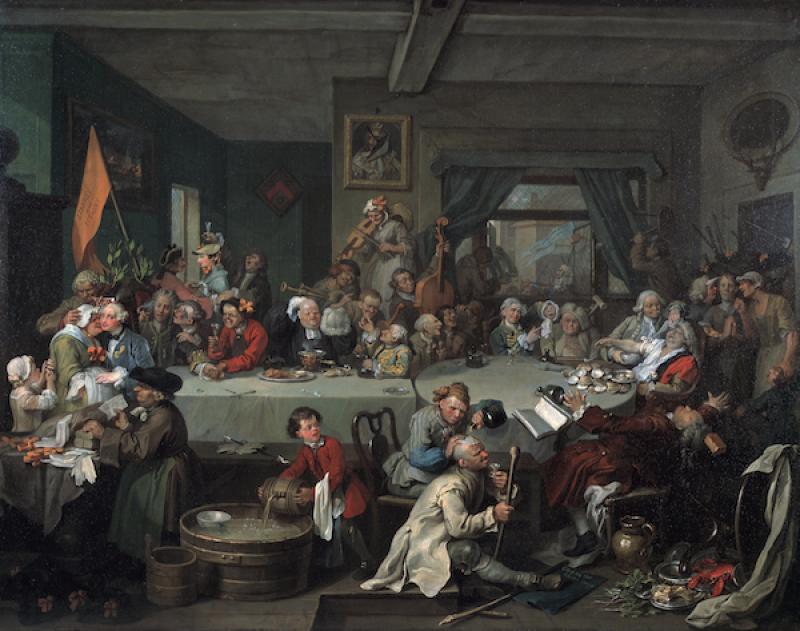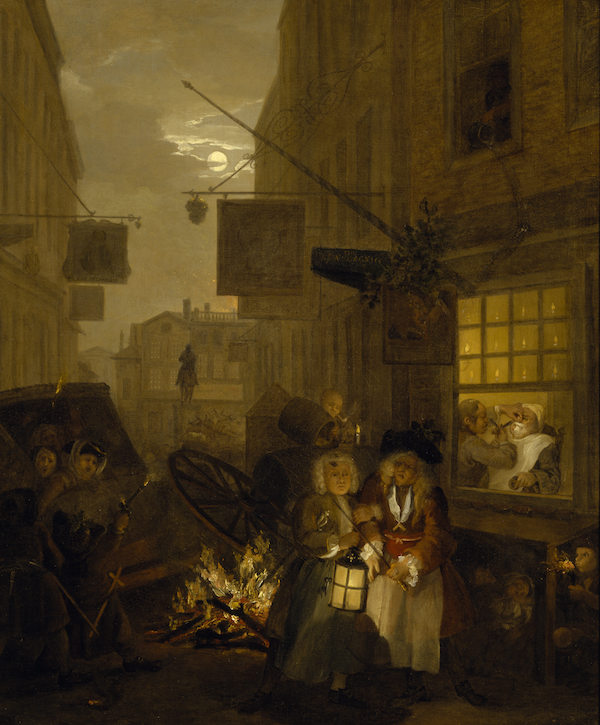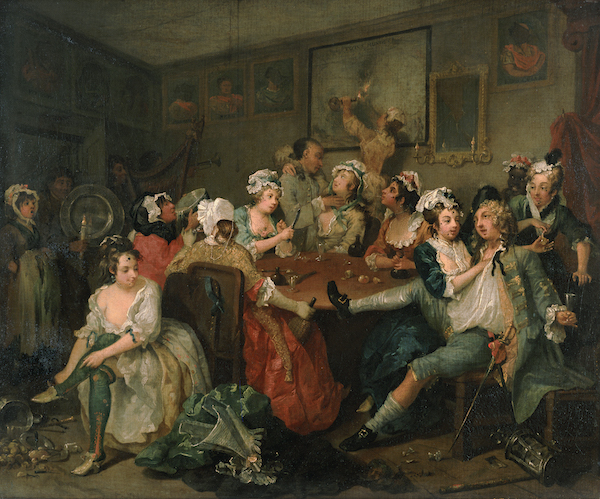Hogarth: Place and Progress, Sir John Soane’s Museum review - state of the nation | reviews, news & interviews
Hogarth: Place and Progress, Sir John Soane’s Museum review - state of the nation
Hogarth: Place and Progress, Sir John Soane’s Museum review - state of the nation
Magnificent show of Hogarth's despair at his fellow citizens and a divided England

Of the British, the English have a reputation for satire. They’re also prone to stupidity. The combination of biting morality and excoriating wit required to deride this tendency reached notable heights in the work of engraver and painter William Hogarth (1697-1764).
Soane’s (1753-1857) long-standing interest in Hogarth’s work did much to revive the artist’s reputation. His wife, Elizabeth Soane, acquired A Rake’s Progress, 1734 (pictured bottom) from a Christie’s auction in 1802. Two decades later, Soane himself bought The Humours of an Election, 1754-55, (pictured top) which had previously been owned by the actor, David Garrick. The years in between these two major purchases were tumultuous. His sons had proved disappointments and his beloved Eliza had died in 1815, her decline reputedly exacerbated as a result of malignant comments made in the press by her younger son George. Fittingly, then, the foreword to the catalogue proposes that together and separately the exhibition’s pieces show how a lifetime’s “spiritual journey” could be undertaken “in a positive or negative way.” They also provide “a social commentary on the artist’s times”.
 For Hogarth, working in (mainly) Protestant England, the rewards of this life and the next effectively mirrored each other. Painterly strategies for conveying moral lapses did not have to be subtle: lax moral rectitude could cause, or be signalled by, slovenly decrepitude. Bad lives met bad ends, notably at the gallows of Tyburn and Rotherhithe. But poverty itself did not signal unworthiness. On show in the basement kitchen is the series Industry and Idleness, 1747, which depicts the trajectories of two London apprentices — the industrious and upstanding Francis Goodchild and the good-for-nothing sot, Tom Idle. The sixth plate shows Goodchild and his wife donating food to the needy and paying street performers for their music and tumbles. However, though the cheap printing of the series consciously placed it well within the means of the London apprentices at whom it was aimed (as a kind of pedagogical guide), even the upright Goodchild couple do not escape a ribbing. Their presence at church bears the hallmarks of ambitious social climbing, and having become Sheriff of London, Goodchild’s feasting companions prove gluttons oblivious to the petitioners crowding the door.
For Hogarth, working in (mainly) Protestant England, the rewards of this life and the next effectively mirrored each other. Painterly strategies for conveying moral lapses did not have to be subtle: lax moral rectitude could cause, or be signalled by, slovenly decrepitude. Bad lives met bad ends, notably at the gallows of Tyburn and Rotherhithe. But poverty itself did not signal unworthiness. On show in the basement kitchen is the series Industry and Idleness, 1747, which depicts the trajectories of two London apprentices — the industrious and upstanding Francis Goodchild and the good-for-nothing sot, Tom Idle. The sixth plate shows Goodchild and his wife donating food to the needy and paying street performers for their music and tumbles. However, though the cheap printing of the series consciously placed it well within the means of the London apprentices at whom it was aimed (as a kind of pedagogical guide), even the upright Goodchild couple do not escape a ribbing. Their presence at church bears the hallmarks of ambitious social climbing, and having become Sheriff of London, Goodchild’s feasting companions prove gluttons oblivious to the petitioners crowding the door.
In spite of their small flaws, however, the Goodchilds prevail. Not so Miss Mary Hackabout or Tom Rakewell, both of whom succumb to lures of the more specious kind — sex, money, gambling — having staked more than they should have upon pretending to be what they are not.
In A Harlot's Progress, 1732, (on display as prints due to the originals being destroyed in a fire), the plump Hackabout — initially met fresh from the countryside, dressed demurely in a white corset topped with a sweet-smelling nosegay — quickly transforms into a lewd and conniving seductress. Upon arrival in London, she quickly dispenses with innocence and shacks up as the mistress of a Jewish merchant. Yet tedium clearly prevails for she takes a lover of her own, a plump-faced young preener of tailcoats and frippery. When the couple are surprised mid-dalliance by the cuckolded merchant’s unexpected return, Hackabout contrives a scene to enable the escape of her beau. Hogarth skewers her self-interest mercilessly, and shows how the weak, the innocent, and the plain naïve are subjected to indignities passed down by those of higher status, greater power, or — merely — vaster manipulative ability. In short, their "betters". The black serving boy looks on aghast as she tips the tea service to the floor with her foot. He’ll take the blame and clear the mess. The pet monkey flees, disturbed, its teeth bared in annoyance that it should be so maltreated. But venality is Hogarth's perennial target, no matter the source. In mimicry of its mistress, the monkey wears a hat and shawl. When betrayal is so easy, Hackabout’s bad treatment of the monkey might allow us a glimpse of what’s round the corner for her: her lover creeps uncomfortably close past the cornered maid in his quest for the open door. Tom Rakewell charts a similarly predictable downward spiral. The first scene of A Rake's Progress, 1734, shows him getting measured for new attire, ready to sally forth from the grimy City of London to break into the aristocratic and wild society of the fashionable West End. He offers his pregnant, spurned girlfriend, Sarah Young, a handful of gold coins. She holds a wedding band between her thumb and forefinger, his promises as empty as its now suggestive hole. But behind Rakewell, a sly lawyer paws a sack of coins. In time, Rakewell will receive his comeuppance. A few scenes on, and he’s fallen into his own void — the Rose Tavern on Drury Lane, a notorious sleaze pit (pictured above). His breeches are undone and ripped at the groin. He's become corpulent and — utterly sozzled — is having his pockets picked. At the table, two prostitutes are engaged in a dispute. One spits at the other's face; the other brandishes a knife. Behind them, another sets fire to a painting. Each is speckled with syphilitic sores. Should we relish the scene? Hogarth goads us to laughter but casts a gimlet eye, warning of excessive levity. After all, the depictions of overindulgence which grace the walls of the many aristocratic but morally rotten entertaining rooms he depicts (such as in Marriage A-la-Mode, 1743-45) seem to have no bearing on his characters’ consciousnesses. And look where that leaves them.
Tom Rakewell charts a similarly predictable downward spiral. The first scene of A Rake's Progress, 1734, shows him getting measured for new attire, ready to sally forth from the grimy City of London to break into the aristocratic and wild society of the fashionable West End. He offers his pregnant, spurned girlfriend, Sarah Young, a handful of gold coins. She holds a wedding band between her thumb and forefinger, his promises as empty as its now suggestive hole. But behind Rakewell, a sly lawyer paws a sack of coins. In time, Rakewell will receive his comeuppance. A few scenes on, and he’s fallen into his own void — the Rose Tavern on Drury Lane, a notorious sleaze pit (pictured above). His breeches are undone and ripped at the groin. He's become corpulent and — utterly sozzled — is having his pockets picked. At the table, two prostitutes are engaged in a dispute. One spits at the other's face; the other brandishes a knife. Behind them, another sets fire to a painting. Each is speckled with syphilitic sores. Should we relish the scene? Hogarth goads us to laughter but casts a gimlet eye, warning of excessive levity. After all, the depictions of overindulgence which grace the walls of the many aristocratic but morally rotten entertaining rooms he depicts (such as in Marriage A-la-Mode, 1743-45) seem to have no bearing on his characters’ consciousnesses. And look where that leaves them.
These disastrous states are not merely the preserve of the individual. Hogarth was born about half a century after the end of the English Civil War, and a mere nine years after the Glorious Revolution of 1688, to a febrile political landscape. The divisions of the nation run through his work. The Humours of an Election depicts bribes being exchanged in front of a Tory tavern, the Royal Oak — advertised by a sign celebrating Charles II’s escape after the Battle of Worcester. In the background, the adjacent Whig tavern is being mobbed. In the Night panel of The Four Times of Day, 1736-37, (pictured above) the equestrian statue of the executed Charles I looms over a scene of chaos and wreckage. Flames lick an overturned coach and a man in a lighted window has his teeth pulled.
Yet Hogarth’s times were not our own, as Gin Lane and Beer Street, 1751, make plain. They were created as a pair to support the (successful) campaign to bring in the Gin Act, which tightened up regulations on distillers and merchants and levied higher fees. While Gin Lane is, notoriously, a scene of ill-repute, Beer Street is prinked and prosperous. The people depicted are, largely, industrious and merry. Beneath, Hogarth extols the virtues of beer: “Labour and Art upheld by Thee / Successfully advance. / We quaff Thy balmy Juice with Glee / And Water leave to France.” On this count at least, Hogarth lived in far more intoxicating times.
- Hogarth: Place and Progress is at Sir John Soane's Museum until 5 January 2020. Free but booking essential
- Read more visual arts reviews on theartsdesk
rating
Explore topics
Share this article
The future of Arts Journalism
You can stop theartsdesk.com closing!
We urgently need financing to survive. Our fundraising drive has thus far raised £49,000 but we need to reach £100,000 or we will be forced to close. Please contribute here: https://gofund.me/c3f6033d
And if you can forward this information to anyone who might assist, we’d be grateful.

Subscribe to theartsdesk.com
Thank you for continuing to read our work on theartsdesk.com. For unlimited access to every article in its entirety, including our archive of more than 15,000 pieces, we're asking for £5 per month or £40 per year. We feel it's a very good deal, and hope you do too.
To take a subscription now simply click here.
And if you're looking for that extra gift for a friend or family member, why not treat them to a theartsdesk.com gift subscription?
more Visual arts
 'We are bowled over!' Thank you for your messages of love and support
Much-appreciated words of commendation from readers and the cultural community
'We are bowled over!' Thank you for your messages of love and support
Much-appreciated words of commendation from readers and the cultural community
 Photo Oxford 2025 review - photography all over the town
At last, a UK festival that takes photography seriously
Photo Oxford 2025 review - photography all over the town
At last, a UK festival that takes photography seriously
![SEX MONEY RACE RELIGION [2016] by Gilbert and George. Installation shot of Gilbert & George 21ST CENTURY PICTURES Hayward Gallery](https://theartsdesk.com/sites/default/files/styles/thumbnail/public/mastimages/Gilbert%20%26%20George_%2021ST%20CENTURY%20PICTURES.%20SEX%20MONEY%20RACE%20RELIGION%20%5B2016%5D.%20Photo_%20Mark%20Blower.%20Courtesy%20of%20the%20Gilbert%20%26%20George%20and%20the%20Hayward%20Gallery._0.jpg?itok=7tVsLyR-) Gilbert & George, 21st Century Pictures, Hayward Gallery review - brash, bright and not so beautiful
The couple's coloured photomontages shout louder than ever, causing sensory overload
Gilbert & George, 21st Century Pictures, Hayward Gallery review - brash, bright and not so beautiful
The couple's coloured photomontages shout louder than ever, causing sensory overload
 Lee Miller, Tate Britain review - an extraordinary career that remains an enigma
Fashion photographer, artist or war reporter; will the real Lee Miller please step forward?
Lee Miller, Tate Britain review - an extraordinary career that remains an enigma
Fashion photographer, artist or war reporter; will the real Lee Miller please step forward?
 Kerry James Marshall: The Histories, Royal Academy review - a triumphant celebration of blackness
Room after room of glorious paintings
Kerry James Marshall: The Histories, Royal Academy review - a triumphant celebration of blackness
Room after room of glorious paintings
 Folkestone Triennial 2025 - landscape, seascape, art lovers' escape
Locally rooted festival brings home many but not all global concerns
Folkestone Triennial 2025 - landscape, seascape, art lovers' escape
Locally rooted festival brings home many but not all global concerns
 Sir Brian Clarke (1953-2025) - a personal tribute
Remembering an artist with a gift for the transcendent
Sir Brian Clarke (1953-2025) - a personal tribute
Remembering an artist with a gift for the transcendent
 Emily Kam Kngwarray, Tate Modern review - glimpses of another world
Pictures that are an affirmation of belonging
Emily Kam Kngwarray, Tate Modern review - glimpses of another world
Pictures that are an affirmation of belonging
 Kiefer / Van Gogh, Royal Academy review - a pairing of opposites
Small scale intensity meets large scale melodrama
Kiefer / Van Gogh, Royal Academy review - a pairing of opposites
Small scale intensity meets large scale melodrama
 Jenny Saville: The Anatomy of Painting, National Portrait Gallery review - a protégé losing her way
A brilliant painter in search of a worthwhile subject
Jenny Saville: The Anatomy of Painting, National Portrait Gallery review - a protégé losing her way
A brilliant painter in search of a worthwhile subject
 Abstract Erotic, Courtauld Gallery review - sculpture that is sensuous, funny and subversive
Testing the boundaries of good taste, and winning
Abstract Erotic, Courtauld Gallery review - sculpture that is sensuous, funny and subversive
Testing the boundaries of good taste, and winning
 Edward Burra, Tate Britain review - watercolour made mainstream
Social satire with a nasty bite
Edward Burra, Tate Britain review - watercolour made mainstream
Social satire with a nasty bite

Add comment